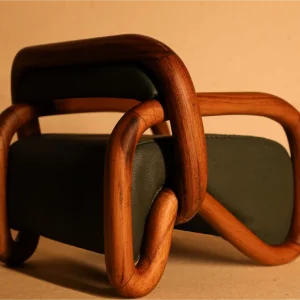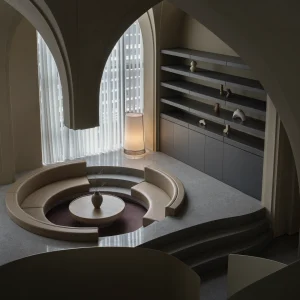
We are very sad to hear that architecture critic and author Martin Pawley has passed away after a long illness. Pawley was a unique voice in architecture who contributed to a wide range of publications throughout his career, including Blueprint and The Architects’ Journal, as well as editing Building Design and World Architecture. In February, Blueprint published a review written by Professor Peter Cook of The Strange Death of Architectural Criticism: Martin Pawley Collected Writings (Black Dog Publishing). As a co-founder of Archigram and long-term friend and sparring partner to Pawley, Cook gave an inspiring and very personal account of the writer’s talents and attitude to architecture. The review is reproduced below as a tribute.
David Jenkins, in his introduction to this book, honours Martin Pawley’s technique as a writer, pointing out that his style can range from Hunter S Thompson to that of the Daily Telegraph. This may be true in terms of manner, but it cannot conceal a special characteristic that seeps through the whole collection, namely that combination of seriousness and a certain elegance of argument that few of the current swarm of architectural writers seem able to emulate.
Pawley often presents the background to his reports in a steady, almost pedantic way, so that in a 1987 piece on the Piccadilly Line train‚ we are reminded that, ‘in the case of the 1973 Tube Stock a car length of 17.8m was finally arrived at’. A 1991 piece on Stansted Airport relates the Foster structure to the fact that ‘laser-levelled floor plates of 25,000m2 are not unusual, and 50,000m2 is not unknown’. Yet his pedantry soon reveals itself to be that of an enthusiast. Pawley is never a mere bystander.
Indeed, my first inkling of him was David Greene, co-founder of Archigram, reading a small piece from the Guardian‚ which mentioned Pawley as a member of a progressive student group at the Oxford School of Architecture and we began to watch out for a potential ally. My first ever stint as a critic at the AA found me defending his spiky architecture and I seem to remember visiting a loft somewhere near King’s Cross where he had constructed a similarly spiky pad for himself in grey and black and white, an aesthetic that reflected the man himself. As Norman Foster suggests in his foreword: ‘You detect Martin’s anger, though it is often disguised beneath a mask of humour… there are people whose historicism offends him so deeply that as you read you can practically hear the wheels of the tumbrill’.
Indeed, it soon emerged that Pawley was a true and genuine believer in progress, in technology and in the thoroughness by which it should be discussed and supported. As with Reyner Banham, he became more than a mere commentator to those of us who were trying to push the boat; he would often catch us and chastise us if we were momentarily being less than true to ourselves.
His writing is quintessentially English and makes much use of anecdote and the deft choice of anecdotal events, which is always a puzzler for our American cousins (who tend to like their opinion fed to them unambiguously). It is even more of a puzzler for the real public for English criticism that now exists, readers who use our words extensively, but for whom it is both a second language and probably a third philosophical tradition. Could you imagine a New York commentator or a Paris critic describing their subject as ‘emerging like Count Dracula as (Nigel) Coates and I sit down like schoolboys at a wooden table… his suit glints with the subtle effect of man-made fibres known only to the few’? The setting, the mix of tastes, the fascination with Coates as having developed from nihilist to planner‚ is illuminated with several more such descriptions and gives Pawley’s writing that special quality that comes from someone who, after all, got into the business through being a combatant himself. I mean: a designer.
If his writing now strikes one as quite dense, quite partisan and essentially quite visual it is because he was quite visual. I put his spiky project in Archigram 5 because it was visually interesting. He became an advocate of technological architecture because he could have so easily been in there drawing it. He became such a consistent and honest critic of Prince Charles’s architectural position because he really hated the stuff as stuff and probably, like most of us, has lived through a constant lovehate relationship with the parallel English traps of invention, obscurantism, fetish, tradition and protocol. Hence his fascination with America and his sorties in and out of the
Victorian world of invention. Another English trait is to be fascinated by those with whom you most disagree, so he relishes his 1991 lunch with Leon Krier (usefully at a time by which Krier had ceased to be fashionable in London, anyway). ‘Leon Krier is an impressive figure. Observing Noel Coward’s advice to the ambitious he always dresses like a stockbroker, albeit with a white scarf, and nowadays even his wild old Abbie Hoffman hairdo has shrunk to Bart Simpson dimensions’. Such observations do not, however, prevent Martin in the same article, from pointing out, quite vehemently, the connections between rational architecture and Hitler. I have no doubt that the book will be devoured by those who still feel that technology, invention and anecdotal culture go together as the principal strands of appropriate architecture. Pushed to the wall to unfurl my flag, I am certainly one.
My realistic hope, however, is that some of these essays will get circulated back into the seminar rooms of the better schools, be treated as seriously as the dreaded Manfredo Tafuri, for Pawley shares some of his socialism but escapes the cloying European grimness of the post-Marxist critics. I really hope that his writings inspire some new generation English schoolboy or girl to make as much serious, witty, observant and creative comment about our creative world.
Image above; Pawley’s design for a Time House, 1967





